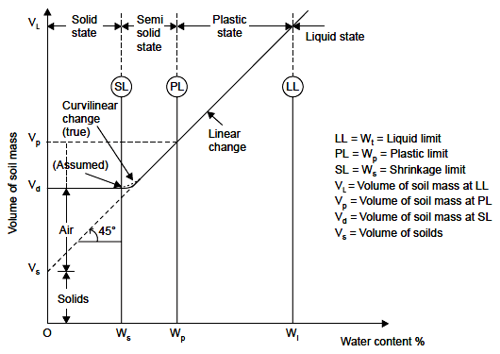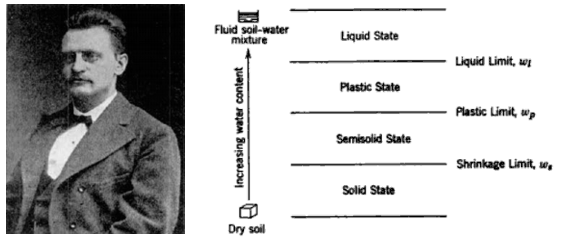1. Atterberg limits:
A soil sample will expose its consitency when it is composed of some clay and silt fractions and has some moisture content. The consistency of a soil sample will change in relation to the changing of moisture content. This relationship is presented by Albert Mauritz Atterberg in the following figure:

|
| Atterberg limits (Source: C. Venkatramaiah, Geotechnical Engineering) |
Based on that concept, Atterberg introduces three limit values (so-called Atterberg limits): liquid limit, plastic limit, shrinkage limit.
- Liquid limit LL is the moisture content at which a soil sample changes from the plastic phase to the liquid phase. In the plastic phase, the volume of the soil sample will decrease linearly with decreasing of moisture content.
- Plastic limit PL is the moisture content at which a soil sample changes from the plastic phase to semi-solid phase. In the semi-solid phase, the volume of the soil sample will decrease curvilinearly with the decreasing of moisture content.
- Shrinkage limit SL is the moisture content at which the soil sample changes from the semi-solid phase to the solid phase. In the solid phase, the volume of soil sample will not change even though its moisture content decreases.
2. Liquidity index of a soil sample:
The consistency of a soil sample is expressed by the parameter "liquidity index", denoted by LI. The liquidity index is calculated by scaling the natural moisture content to the liquid limit and plastic limit by the following formula:
![]()
However this comparison is illogical because of some reasons as follows:
- The moisture content of a soil sample is carried out on the whole sample including both a coarse portion (considered as a non-plastic component) and a fine portion (considered as a plastic component).
- The liquid limit and plastic limit are carried out on the fine portion only. The boundary between a coarse portion and a fine portion is dependent on applied standards. For instance, this boundary is 1.0 mm for Vietnamese standard and 0.425 mm for ASTM or BS.
3. Corrected liquidity index:
In order to have a more logical liquidity index, researchers introduces a method of correction for the liquidity index: either the moisture content will be corrected to the equivalent moisture content of a fine portion; or the liquid limit and plastic limit will be corrected to the equivalent limits for the whole sample.
| Applied standard | Method of correction | Range of correction |
| Vietnamese standard TCVN 4197:1995 |
Liquid limit and plastic limit are corrected to their equivalent limits for the whole sample.
The corrected liquidity index is calculated by following formula:
where: w is the natural moisture content of a soil sample PL* and LL* are corrected values of plastic limit and liquid limit, using the following formula:
Pa is the cumulative percentage of particles passing 1.0 mm |
The correction is applied only for samples whose coarse portion (> 1.0 mm) is from 10 % to 50 % |
| British standard BS 1377:1990 |
The natural moisture content w of a soil sample is corrected to the equivalent moisture content wa of a fine portion only.
(Pa is the cumulative percentage of particles passing 0.425 mm) Then the liquidity index is calculated by following formula:
|
The correction is applied for all samples |
| American standard ASTM D4318 |
no correction required | - |
Meanwhile BS 1377 requires to make the correction for every samples regardless its amount of coarse portion but Vietnamese standard TCVN 4197 only applies the correction for samples whose coarse portion are between 10 % and 50 %.
How does TCVN 4197 find out the limit values of 10 % and 50 % ?Are these limit values logical ? These questions have no answers so far ![]()













